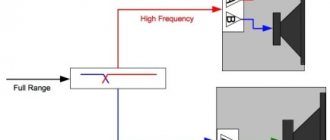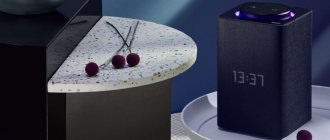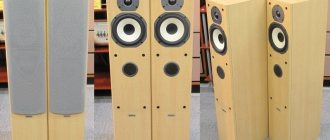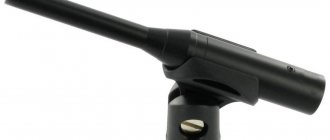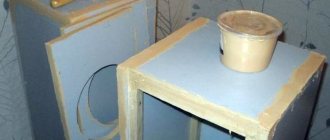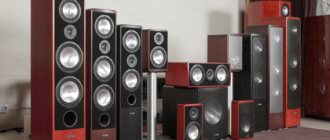The suspension of the electrodynamic head is an important part of its moving system. It is located along the perimeter of the diffuser and ensures elastic movement of the acoustic emitter. For powerful loudspeakers, the vibration amplitude of the cone can be large, so the suspension must ensure free movement of the system and dampen sudden vibrations.
For low-power acoustic emitters, the diffuser and shock absorber are one piece and are stamped from semi-liquid paper pulp, followed by the formation of annular grooves that form a corrugated damper. Powerful speakers are equipped with rubber or polyurethane suspension. Mechanical damage to this part is the most common defect in speaker systems.
What can a speaker hanger be made from?
During extreme use of acoustic systems, and over time, the diffuser mount is the first to be destroyed. In this case, the diffuser itself and the voice coil are not damaged, so the electrodynamic head remains fully operational. It remains to solve the problem with the defect that has arisen. Considering that high-quality products from branded manufacturers are very expensive, many craftsmen make homemade speaker suspension. The material for this can be any elastic synthetic material. First, you need to completely remove the old part that has failed on the dynamic head. Remains of adhesive are removed from the perimeter of the diffuser and the metal body. If the diffuser needs to be cleaned very carefully, then the glue from the diffuser holder is washed off with any active solvent.
RESTORATION OF FABRIC ACOUSTIC SUSPENSIONS
For systems built according to the principles of the HIENDMUSIC PHILOSOPHY , I recommend vintage acoustics from the Golden Era of hi-fi, but I always warn that the best models of speakers usually need serious restoration work. Ten years ago it was still possible to hear good sound from vintage speakers in as-is condition, but the degradation of certain technical components - mainly suspensions - is increasing like an avalanche, and today it is almost impossible to find Diatone or Technics speakers that could sound good without restoration intervention. (note: Technics speakers have rubber suspensions - the title of the article contains a mention of fabric suspensions, as at the time of the new edition of the article the link was indexed)
In addition, the steady demand for vintage acoustics reduces the number of preserved examples on the market every day, and those wishing to purchase top-end and pre-top-end speaker models increasingly have to be content with copies in the same condition as in the photo below.
Is it possible to restore such acoustics? Let's start with Diatone, since the photo of these speakers was posted first. Hiendmusic recommends purchasing Diatone acoustics of at least 2000 series:
Diatone DS 5000 and Diatone V5000 can form the basis of the highest level system;
Diatone DS 3000 is an excellent option for a top-end setup for small spaces;
Diatone DS 2000 are excellent speakers for an inexpensive setup.
All Diatons are distinguished by a rich, driving sound, which can sometimes seem overly bright and harsh, which is more likely explained by the combination of digital sources with transistor amplification than by a feature of speakers created in the analogue era.
The internal filters of the Diatons are reliably assembled from high-quality elements and to this day they work perfectly - there are no problems with them, and if they arise, it is not difficult to replace the “tired” parts - you don’t have to be afraid of it. Tweeters and dome midrange drivers have membranes made of titanium and titanium-boron. This is a fragile material, and broken tweeters and midrange speakers are a common result of careless transportation of speakers. In this case, the domes have to be replaced with “donor” ones, but this is a force majeure accident, and if the domes are intact, nothing needs to be done to the speakers. Unless you carefully clean the membranes.
The only element of Diatone acoustics that requires mandatory intervention is the fabric surrounds of the bass and midbass speakers. They are coated on the inside with a special resin, which dries to the state of amber on all speakers, without exception. Suspensions with such resin, instead of the normal elastic-elastic state, become rigid, and the speakers do not sound correctly.
Boomy, boxy bass, or no bass at all, or a harsh, shouty midrange are a common result of using Diatones with hard surrounds. In the photo below you can see dried resin on the inside of the Diatone DS 5000 midwoofer surround. Please note that under the influence of gravity, the resin gradually flowed from the top of the surround to the bottom, resulting in a thick, durable crust underneath. Because of this, the diffuser not only lacks the required mobility, but also works with distortion.
A common way to soften hard hangers is to coat them with a special liquid that dissolves the resin. This liquid is sold in Japan and you can easily find several offers online. The problem is that softening the suspensions in this way helps for a short period of time - from three months to six months. Then the process must be repeated again, and after a certain number of cycles, the resin on the suspension finally degrades, depriving the speakers of the correct sound forever, or, rather, until a deep restoration intervention is carried out.
Another problem associated with the Japanese liquid is the stupid YouTube videos where Diatone owners demonstrate how soft their suspension is. Because of these videos, many people think that the suspensions need to be softened to the limit, turning them into snot, and again, depriving the speakers of the opportunity to sound correctly until they are completely restored.
When I offer to hiendmusic customers , I immediately carry out a complete restoration of the suspensions according to a recipe that I developed over three months through trial and error. The photo shows some of the experimental mixtures that were rejected as a result of dozens of experiments.
In the end, I managed to choose the right recipe and now, after my processing, the Diaton speakers sound perfect, and the result remains for many years. I must warn you right away that I will not reveal the processing secret.
In addition to restoring the suspensions, Diatone acoustics often require cosmetic repairs to the cabinets and painting of the gold-plated speaker rims - they are almost always covered with unsightly corrosion.
As a result of restoration, the acoustics acquire a collectible appearance and sound great. The photo below shows the same couple whose photographs were at the beginning of the article. Now it plays great in the system of one of my customers.
Another model of acoustics that definitely requires restoration, and more serious than Diatone, is the Technics SB 8000. This is an excellent phase-linear acoustics with paper diffusers, capable of reproducing music that is not too heavy (up to and including hard rock) with the naturalness of a live club stage. Imagine my surprise when several clients to whom I recommended listening to these speakers at various points of sale returned disappointed. “A sharp, disgusting sound, impossible to listen to,” was the unanimous verdict.
The situation became clearer when some of these “technicians” ended up in my workshop. The second speaker from the top of these speakers is a paper mid-high speaker, responsible for frequencies of 1100-4000Hz and must have a special foam damper on the inside. On all speakers of these models, without exception, such a damper has dried out and crumbled over time, as a result of which the diffuser does not operate in the mode in which it should.
In addition, paper diffusers, which have been exposed to moisture, soot and grease for many years, have lost the required rigidity and become softer than necessary. The same goes for thin rubber hangers. All these factors, when added together, turn the Technics SB 8000 into an “out-of-tune piano,” and it is not surprising that the sound of these speakers, even in the best cosmetic condition, disappoints many. To restore their sound, and not just external freshness, serious work with the speakers is required.
A special composition returns elasticity to flabby rubber suspensions.
Paper diffusers are cleaned and coated on both sides with two special compounds.
The dried damper is replaced with a new foam ring with special impregnation.
After all the work, the Technics SB 8000 sound completely different. Some people ask how can I be sure that this is the same sound as it was forty years ago? I don’t need confidence that this is the “right” sound - just an absolutely natural sound is enough. With an analog source, these speakers, after restoration, play so that you feel like you are at a live concert in the front row of a good music club. What else is needed? You can listen to a short fragment on this VIDEO - I recommend connecting headphones.
A few more words need to be said about amplification for the listed acoustics. Tube-transistor bi-amping works best when the upper section of the acoustics is powered by a tube push-pull integrated circuit, and the lower section is powered by a transistor integrated circuit.
At the same time, only the Diatone DS 5000 has the standard ability to connect two amplifiers. Biamping setups with the Diatone DS 3000 and Technics SB 8000 require the installation of additional terminals and the inclusion of an active crossover or a preamplifier with a built-in active crossover into the system. This upgrade allows you to get the most out of the acoustics and get a system with outstanding sound.
Descriptions of such setups can be found on this page.
You can order a preamplifier with a built-in crossover for your biamping system by writing to I recommend that you consult first.
DIY speaker diffuser suspension
To understand how to make speaker hangers yourself, you need to determine the properties of the material. It should be easy to process, flexible and durable. In addition, the material must adhere well. Conventional leatherette meets these conditions. A dynamic head is placed on a piece of leatherette, slightly larger in size than the outer diameter of the product, and outlined around the perimeter with a pencil. When marking the internal hole, it is best to use the old diffuser mount. Then the finished pattern should be placed on an elastic material for ease of work, and with a sharp scalpel the workpiece should be cut along the intended contours. If there is no scalpel, then making the speaker diffuser suspension is done with a razor blade.
To make the material more elastic, it is recommended to remove the fabric layer from the leatherette blank, leaving only the synthetic base. You can glue the new part to the diffuser and diffuser holder using rubber glue. Since the glue is thick, it must be diluted with gasoline and applied with a brush in several layers. Self-made speaker hangers made of leatherette can somewhat degrade the performance of the speaker system, so for high-quality sound reproduction you need to use another method.
Homemade speaker hangers
Making a high-quality speaker suspension with your own hands, the work is not too difficult. If you have everything you need, then you can make a defective element that is almost no different from the branded one. Good results are obtained when using porous rubber or ethylene-propylene rubber (EDPM) as the speaker suspension material.
To do this you will need a punch, a die and a base. To obtain a “wave” on the material, aluminum wire 6 mm thick is used. Two blanks are cut from PCB. You will also need an aluminum plate 8-10 mm thick. A sheet of porous rubber is laid between the workpieces. A ring of thick aluminum wire is placed in the groove between them. It will provide a semicircular protrusion on the finished product, as is done with branded hangers. The entire package is screwed onto an aluminum plate. In order for the product to maintain its shape, the rubber blank must be heated. To do this, the plate is placed on the iron. Its power regulator should be set to the maximum value and the workpiece should be heated for 20-25 minutes. In this case, the rubber layer heats up to 160 degrees, and the characteristic smell of burnt rubber begins to emanate from the workpiece and a small amount of smoke appears. Heating should be stopped immediately. A do-it-yourself rubber speaker hanger is cut to exactly the size of the dynamic head and glued with rubber glue. If all the work is done carefully, the finished product will be almost no different from the branded one. Almost any loudspeaker can be restored using this method.
Diatone speaker suspensions and their prevention
Many wonderful acoustic systems have been created in the world that use absolutely fantastic technologies in their production. Yamaha made speaker domes from berylium, Diatone foamed boron by depositing it on a titanium substrate, Sony grew speakers using bacteria acetobacteriae aceti (biocellulose), etc.
Sony SS-A5 La Voce (the tweeter was created by bacteria acetobacteriae aceti)
But when it comes to the sound of these speaker systems today (yes, they still sound great), some factors are slightly forgotten - not all speaker components have an infinite resource, or may at some point deteriorate their properties.
Yamaha NS-1000 and beryllium domes
For example, many Onkyo speakers have PPU suspensions that attach the diffuser to the basket. This means that the service life of PPU (foam rubber, polyurethane foam) is only 10-15 years. And if you buy the beautiful Onkyo Scepter, you can watch in surprise how when you turn up the volume, shreds of suspensions fly in all directions. Of course this is not scary, the suspensions change. You can exchange it for the same polyurethane foam, rubber or fabric, and there are specialists who will carry out this operation carefully. But as you can see, there really is a topic of nuances in acoustics that is worth talking about. Today our attention is entirely devoted to the acoustics of Diatone (a division of Mitsubishi). This is a wonderful acoustics, and even its not the most expensive 77HR models are exalted by some audio enthusiasts as competitors of modern acoustics up to $4,500. I would laugh at such a statement, but you know, in some moments it’s really true. This is all debatable in general, but of course this is acoustics of fantastic quality that exceeds its price.
Diatone DS-77Z is the newest in terms of year of manufacture; their suspensions can still be pristinely soft.
But starting from the 80s and, accordingly, models 505-501 and then 77-1000-5000, etc., the main feature of these speakers is suspension. In production, for durability, they were impregnated with something (resins, rubber?) and initially they were tender and soft, but after decades, almost always, if you get acoustics first-hand from a Japanese person, without preventive maintenance you will get “hardened” fabric suspensions in all models of the 80s. A huge plus is that these are fabric hangers, which means that they are virtually eternal.
Diatone DS-505 - flagship of 1980.
But what are the dangers of hardening (hardening of suspensions)? The speaker can no longer respond so accurately to changes in the signal and the first effect of hardening is a decrease in the depth of low frequencies. You know, sometimes this is even good; if your listening room is prone to resonances, then the effect of “oak” suspensions will even be beneficial. I listened to the Diatone DS-77HR in a completely wildly resonating room, where I couldn’t listen to any acoustics (due to the resonances there was a terrible loss of resolution, as if you were listening to a stereo system) and only the 77HR played without any sign of resonance, just fine. And I didn’t even have the idea or the meaning of processing the suspensions - I was 100% satisfied with the result. But what exactly can prompt the prevention of dewlaps to return softness to the dewlap, and is this even possible? 1. We can restore to some extent the depth of the once low frequencies (just remember that the closed box form factor (BY) will not give you a very deep low end in this size of case). And the second reason is not so obvious, but I have encountered its consequences. As a result of the suspensions becoming stiff, the fabric loses its elasticity and becomes brittle and brittle when bending. The result of completely fatal drying can be cracks in the fabric - then only changing the hanger is the only recipe. Therefore, if you really like your Diatones and want to listen to them for as long as possible, then one of the desires is to restore the elasticity of the suspensions and thereby extend their life. You know, I tried many homemade recipes from local Kulibins, including castor oil, etc. - all of this has a very weak effect. The only guaranteed effect is a certain Japanese “secret” liquid that can soften Diatone suspensions. Nobody knows its composition, and unfortunately, neither do I. It is sold in Japan at a price of 1,500 yen, but with delivery it costs around 4,000 rubles for 2 bottles. A couple of years ago I bought these bubbles and the bubbles I received were quite large. But having ordered a similar thing at the end of 2016, I also received 2 bottles, but how tiny they became! I was very unpleasantly surprised.
The Japanese secret liquid for softening the suspension is some kind of solvent.
Judging by the smell, it’s definitely some kind of solvent (I think it’s actually cheap), but I couldn’t identify it. It does not smell like acetone or white spirit or galoshes (I sniffed everything I found at home), but the amber is generally similar.
An example of Japanese greed
Whoever reveals the secret of this very liquid will help many audio enthusiasts. To test the liquid, I had Diatone DS-501 acoustic systems with moderately hardened suspensions. They were a little firm, but not to the point where I was worried about the fabric tearing. But I didn’t listen to these speakers for long, because despite their high musical resolution and spaciousness, the midrange from the giant dome and the highs with modest bass blew my mind in about half an hour. It turned out that since the woofer reduced the intensity of the low frequencies, the high frequencies/mid frequencies came to the fore - it is logical that this is how these swings work.
We wipe the suspension with liquid using these sticks
I put the speaker on the floor - speakers up. I wiped the pendant with alcohol to remove any dust. After which I took a Japanese bottle of liquid and a cotton swab (for the ears). Dipping the stick into the liquid, I began to carefully apply the liquid to the pendant until I covered it completely. After waiting an hour or two, I saw that the suspension began to soften. I walked around the entire circumference again. After another 2-3 hours I made a third coating. Each time the softness of the suspension increased. Ultimately, 3 passes are required - this is not only my experience, but also that of comrades who have performed similar operations. After 3 passes we leave the suspension until the morning. In the morning you receive the most delicate suspension, which reacts with lightning speed to any changes in sound.
Diatone DS-501
What has changed in the sound? In this case, the Diatone DS-501 acquired softer and deeper low frequencies, and most importantly, they evened out the tonal balance, now all the HF/MF/LF frequencies were in the correct proportions and began to be listened to organically, without dominating one over the other. The sound has noticeably changed for the better and I got acoustics that sound just as great as when they left the assembly line.
Well, in conclusion, all that remains is to demonstrate what was said in the video:

